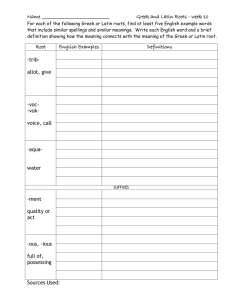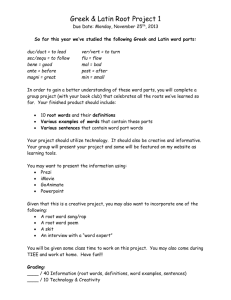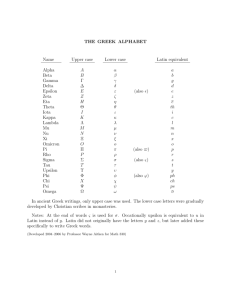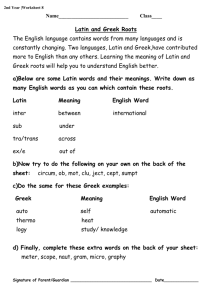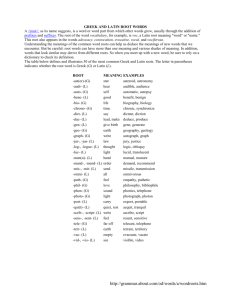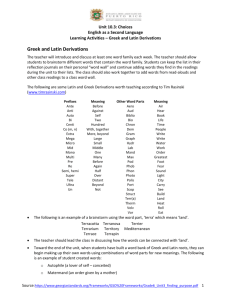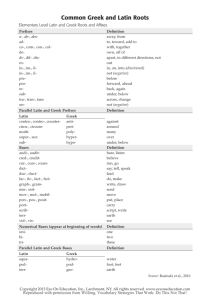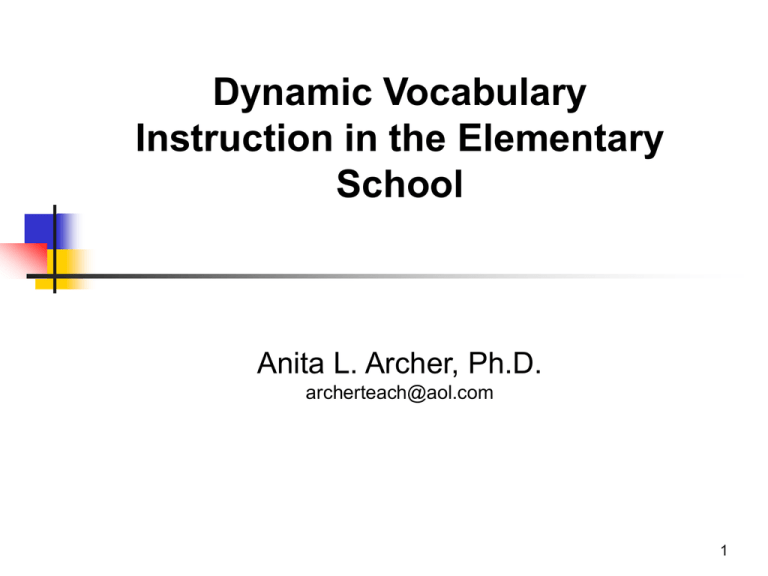
Dynamic Vocabulary
Instruction in the Elementary
School
Anita L. Archer, Ph.D.
archerteach@aol.com
1
Topics
•
•
•
•
•
•
Importance of Vocabulary Instruction
Components of a Vocabulary Program
Read-Alouds
Explicit Vocabulary Instruction
Word-Learning Strategies
Independent Reading
2
Importance of Vocabulary
Instruction
•
Receptive Language
•
Reading Comprehension (Chall, Jacobs, & Baldwin, 1990; Nagy, 2005; Scarborough, 1998, Stahl &
Fairbanks, 1987)
•
•
Expressive Language
•
•
•
•
•
Listening Comprehension
Writing
Speaking
Overall Reading Achievement (Stanovich, et al., 1993)
Overall School Success (Becker, 1977; Anderson & Nagy, 199l)
Hallmark of an Educated Individual (Beck, McKeown, Kucan, 2002)
3
Importance of Vocabulary
Instruction
•
Children’s vocabulary in the early grades related to
reading comprehension in the upper grades.
•
Preschool -Children’s vocabulary correlated with reading
comprehension in upper elementary school. (Dickinson & Tabois,
2001)
•
Kindergarten -Vocabulary size was an effective predictor
of reading comprehension in middle elementary years.
(Scarborough, 1998)
•
First Grade -Orally tested vocabulary was a significant
predictor of reading comprehension ten years later.
(Cunningham & Stanovich, 1997)
•
Third Grade -Children with restricted vocabulary have
declining comprehension scores in the later elementary
years. (Chall, Jacobs, & Baldwin, 1990)
4
Importance of Vocabulary
Instruction
Vocabulary Gap
Children enter school with different levels of
vocabulary. (Hart & Risley, 1995)
By the time the children were 3 years old, parents in less economically
favored circumstances had said fewer words in their cumulative monthly
vocabularies than the children in the most economically advantaged
families in the same period of time.
Cumulative Vocabulary (Age 4)
Children from professional families
Children from working class families
Children from welfare families
1100 words
700 words
500 words
5
Importance of Vocabulary
Instruction
Vocabulary Gap
Meaningful Differences in Cumulative
Experiences (Hart & Risley, 1995)
Words heard per
hour
Words heard in a
100-hour week
Words heard in a
5,200 hour year
3 years
Welfare
620
62,00
3 million
10 million
Working Class
1,250
125,000
6 million
20 million
Professional
2,150
215,000
11 million
30 million
6
Importance of Vocabulary
Instruction
Vocabulary Gap
Linguistically “poor” first graders knew 5,000 words; linguistically “rich”
first graders knew 20,000 words. (Moats, 2001)
Children who enter school with limited vocabulary knowledge grow more
discrepant over time from their peers who have rich vocabulary
knowledge. (Baker, Simmons, & Kame’enui, 1997)
The number of words students learn varies greatly.
2 versus 8 words per day
750 versus 3000 words per year
By the end of second grade, 4,000 word difference in root vocabulary of
children in highest vocabulary quartile & lowest quartile. (Biemiller, 2004)
7
Importance of Vocabulary
Instruction
Vocabulary Gap
Gap in word knowledge persists though the elementary
years. (White, Graves, & Slater, 1990)
The vocabulary gap between struggling readers and
proficient readers grows each year. (Stanovich, 1986)
After the primary grades, the “achievement gap” between
socioeconomic groups is a language gap.(Hirsh, 2002)
For English Language Learners, the “achievement gap”
is primarily a vocabulary gap. (Carlo, et al., 2004)
8
Importance of Vocabulary
Instruction Conclusion
To close the vocabulary gap,
vocabulary acquisition must be
accelerated through intentional
instruction.
Vocabulary instruction must be a focus
in all classes in all grades.
9
Components of a Vocabulary
Program
High-quality Classroom Language (Dickinson, Cote, &
Smith, 1993)
Reading Aloud to Students (Elley, 1989; Senechal, 1997)
Explicit Vocabulary Instruction (Baker, Kame’enui, &
Simmons, 1998; Baumann, Kame’enui, & Ash, 2003; Beck & McKeown, 1991; Beck,
McKeown, & Kucan, 2002; Biemiller, 2004; Marzano, 2004; Paribakht & Wesche, 1997)
Word-Learning Strategies (Buikima & Graves, 1993; Edwards, Font,
Baumann, & Boland, 2004; Graves, 2004; White, Sowell, & Yanagihara, 1989)
Wide Independent Reading (Anderson & Nagy, 1992;
Cunningham & Stanovich, 1998; Nagy, Anderson, & Herman, 1987; Sternberg, 1987)
10
High Quality Classroom
Language
Use high quality vocabulary in the classroom.
To ensure understanding,
Tell students the meaning of words when first used.
Pair in the meaning of the word by using parallel
language. “Please refrain from talking.
“Don’t procrastinate on your project. Procrastinate means to put off
doing something.”
Please don’t talk.”
“Laws have their genesis…their beginning…in the legislative branch.”
“What is your hypothesis… your best guess?”
These are examples of “fast mapping” in which brief
explanations are given for many words.
11
Read-Alouds
Vocabulary can be gained from listening to
others read.
Listening to a book being read can significantly
improve children’s expressive vocabulary. (Nicholson &
Whyte, 1992; Senechal & Cornell, 1993)
Print vocabulary is more extensive and diverse than oral vocabulary.
(Hays, Wolfe, & Wolfe, 1996)
Wide disparities exist in the amount of time parents read to their
children before lst grade.
Adams (1990) estimated that she spent at least 1000 hours reading books to her son before he entered first grade.
Teale (1984) observed that in low-income homes the children were read to for about 60 hours prior to first grade.
12
Read-Alouds
Choose interesting, engaging stories that attract and
hold children’s attention. The books should also be
somewhat challenging. (Biemiller, 1995; Elley, 1989)
Use performance-oriented reading. Read with
expression and enthusiasm.
Provide students with a little explanation of novel
words that are encountered in context. This is
another example of “fast mapping”.
(Brabham & Lynch-Brown, 2002; Brett, Rothlein & Hurley, 1996; Beck, Perfetti, & McKeon, 1982; Elley, 1989; Penno,
Wilkinson, &Moore, 2002; wasik & Bond, 2001; Whitehurst et al., 1998)
13
Read-Alouds
Actively engage students during the story book
reading to increase vocabulary gains. (Dickerson & Smith, 1994;
Hargrave & Senechal, 2000; Senechal, 1997)
Ask questions that promote passage comprehension.
Retell and prediction questions are particularly useful.
Use a variety of responses including:
Group (choral) responses
Partner responses
Physical responses
14
Read-Alouds
For young students, read the book several times to
increase greater gains in vocabulary. (Senechal, 1997)
Provide a rich discussion before and after reading of
the book.
“What was your favorite part of the book?”
“What really surprised you in the story?”
“What would be another ending for the story?”
15
Read-Alouds
Did the teacher:
1. Select an interesting, engaging, challenging
book? Yes No
2. Read the book with enthusiasm and
expression? Yes No
3. Provide a little explanation of novel words?
Yes No
Example words:
4. Actively engage the students? Yes No
16
Explicit Vocabulary Instruction
Preliminary evidence..suggests that as late
as Grade 5, about 80% of words are
learned as a result of direct explanation,
either as a result of the child’s request or
instruction, usually by a teacher. (Biemiller, 1999)
17
Explicit Vocabulary Instruction
Sources of words for vocabulary instruction
WORDS from read-aloud books
WORDS from core reading programs
WORDS from reading intervention programs
WORDS from content area instruction
Math
Science
Social studies
Health
Art, PE, music, etc.
18
Explicit Vocabulary InstructionSelection of Vocabulary
Select a limited number of words for robust,
explicit vocabulary instruction.
Three to ten words per story or section in a
chapter would be appropriate.
Briefly tell students the meaning of other
words that are needed for comprehension.
19
Explicit Vocabulary InstructionSelection of Vocabulary
Select words that are unknown.
Select words that are critical to passage
understanding.
Select words that students are likely to encounter
in the future and are generally useful. (Stahl, 1986)
Focus on Tier Two words (Beck & McKeown, 2003)
Academic Vocabulary
Select words that are more difficult to obtain.
20
Explicit Vocabulary InstructionSelection of Vocabulary
(Beck & McKeown, 1985)
Tier One -Basic words
Tier Two -Words in general use, but not
common
chair, bed, happy, house
concentrate, absurd, fortunate, relieved, dignity,
convenient, observation, analyze, persistence
Tier Three -Rare words limited to a specific
domain
tundra, igneous rocks, weathering, constitution, area,
sacrifice fly, genre, foreshadowing
21
Explicit Vocabulary InstructionSelection of Vocabulary
Goldilocks Words”
Not too difficult
Not too easy
Just right
(Stahl & Stahl, 2004)
22
Explicit Instruction - Practice Activity Select words for robust, explicit
instruction. (Read-alouds)
Second Graders
Fifth Graders
Enemy Pie by Derek Munson
The Family Under the Bridge by Natalie
Savage Carlson (for Chapter 1)
Perfect
Monsieur
Trampoline
Cathedral
Enemy
Cowered
Recipe
Hidey-hole
Disgusting
Hyacinths
Earthworms
Fragile
Ingredients
Oleanders
Horrible
Gratitude
Nervous
Fastidious
Invited
Loitering
Relieved
Roguish
boomerang
adventure
23
Explicit Instruction - Practice Activity Select words for robust, explicit
instruction. (Core Reading)
McMillan/McGraw Hill – 2nd
Open Court – 2nd
swift
jalapeno
escaped
ingredients
hidden
dough
machine
knead
swaying
recipe
fierce
mixture
mussel
medusa
24
Explicit Instruction -Practice Activity –
Select words for robust, explicit
instruction. (Core Reading)
Harcourt – 2nd
dappled
entranced
trooped
circling
adorable
assortment
habitat
immense
25
Explicit Instruction of Words
-Selection of words
Also, teach idioms (A phrase or expression in
which the entire meaning is different from the usual
meaning of the individual words.)
“The car rolling down the hill caught my eye.”
“Soon we were in stitches.”
“The painting cost me an arm and a leg.”
“The teacher was under the weather.”
26
Explicit Instruction –
Prepare - Student-Friendly Explanations
Dictionary Definition
relieved - (1) To free wholly or partly from pain,
stress, pressure. (2) To lessen or alleviate, as pain or
pressure
Student-Friendly Explanation (Beck, McKeown, & Kucan, 2003)
Uses known words.
Is easy to understand.
When something that was difficult is over or never
happened at all, you feel relieved.
27
Explicit Instruction –
Prepare - Student-Friendly
Explanations
Dictionary Definition
Attention -a. the act or state of attending through applying the
mind to an object of sense or thought b. a condition of readiness
for such attention involving a selective narrowing of
consciousness and receptivity
Explanation from Dictionary for English Language
Learners
(Elementary Learner’s Dictionary published by
Oxford)
Attention -looking or listening carefully and with interest
28
Explicit Instruction- Practice Activity
Write Student-Friendly Explanations
Dictionary Definition
Student Friendly
Explanations
disgusting- to cause to feel
disgust, be sickening, repulsive,
or very distasteful to
fragile- easily broken, damaged,
or destroyed
gratitude- a feeling of thankful
appreciation for favors or
benefits received
loitering – to linger in an aimless
way; spend time idly
29
Student-friendly Explanations
Do I need to rewrite???
dappled -If something is dappled, it has spots, streaks or
patches of different colors or shades.
entranced -If you are entranced by something, it has
delighted or amazed you.
immense -If something is really big or huge, it is immense.
mixture -something made up of different things that are
put together
ingredients -parts that go into a mixture
swift -fast
fierce -ready to fight or hurt something
swaying -bending slowly back and forth
30
Instructional Routine for
Vocabulary
Step 1. Introduce the word.
a) Write the word on the board or overhead.
b) Read the word and have the students
repeat the word. If the word is difficult to
pronounce or unfamiliar have the students
repeat the word a number of times.
Introduce the word with me.
“ This word is compulsory. What word?”
31
Instructional Routine for Vocabulary
(continued)
Step 2. Introduce meaning of word.
Option # 1. Present a student-friendly
explanation. a) Tell students the explanation. OR
b) Have them read the explanation with you.
Present the definition with me.
“When something is required and you must do it, it is
compulsory. So if it is required and you must do it, it is
_______________.”
32
Instructional Routine for Vocabulary
(continued)
Step 3. Illustrate the word with examples.
a) Concrete examples.
b) Visual examples.
c) Verbal examples.
(Also discuss when the term might be used and who might
use the term.)
Present the examples with me.
“Coming to school as 5th graders is compulsory.”
“Stopping at a stop sign when driving is compulsory.”
33
Instructional Routine for Vocabulary
(continued)
Step 4. Check students’ understanding.
Option #1. Ask deep processing
questions.
Check students’ understanding with me.
“Many things become compulsory. Why
do you think something would become
compulsory?”
34
Instructional Routine for Vocabulary
(continued)
Step 4. Check students’ understanding.
Option #2. Have students discern between
examples and non-examples.
Check students’ understanding with me.
“Is going to school in 5th grade compulsory?” Yes
“How do you know it is compulsory?” It is required.
“Is going to college when you are 25 compulsory?”
“Why is it not compulsory?” It is not required. You get to choose to go
to college.
35
Instructional Routine for Vocabulary
(continued)
Step 4. Check students’ understanding.
Option #3. Have students generate their
own examples.
Check students’ understanding with me.
“There are many things at this school that are
compulsory? Think of as many things as you can?”
“Talk with your partner. See how many things you can
think of that are compulsory.”
36
Instructional Routine for Vocabulary
(continued)
Did the teacher:
1. Introduce the word?
2. Present a student-friendly explanation?
3. Illustrate the word with examples?
4. Check students’ understanding?
37
Practice Lesson –
Teach this word to your partner
1. Introduce the word.
This word is assortment. What word?
2. Present a student-friendly explanation.
If you see a variety or mixture of things, you see an
assortment.
3. Illustrate with examples.
If I have many different colors of blocks, I have an ________.
If I have a box of cards for all holidays, I have an ________.
If I have gift boxes of all sizes, I have an ______.
38
Practice Lesson –
Teach this word to your partner
4. Check understanding.
Examples and Non-examples
Get ready to tell me if this is an assortment.
I have three red marbles, two green marbles, six blue marbles, and ten
multi-colored marbles. Do I have an assortment?
I have twelve green marbles. Do I have an assortment?
I have a box of red crayons. Do I have an assortment?
I have a box of 64 different crayons. Do I have an assortment?
Generate Examples
Complete this sentence. I could buy an assortment of ____.
39
Practice Lesson –
Teach this word to your partner
1. Introduce the word.
This word is habitat. What word?
2. Present a student-friendly explanation.
If a plant or animal lives in a particular place in nature,
that is its habitat.
3. Illustrate with examples.
So if black bears live in the forest, the forest is their
________.
If ants live in the soil, the soil is their ___________.
If herons live near ponds, the area around the
pond is their______.
40
Practice Lesson –
Teach this word to your partner
4. Check understanding.
Ask deep processing questions
Would a rain forest be a good habitat for an animal that likes dry
weather and a lot of sand? Explain.
Would the desert be a good habitat for ducks? Explain.
Would the jungle be a good habitat for tigers? Explain.
Would the ocean be a good habitat for trout? Explain.
41
Explicit Vocabulary
Instruction -Review
After teaching the group of vocabulary words, review
the words using a “word association” activity.
Words written on board or overhead:
enemy, disgusting, invited,
relieved
“Tell me the word that I am thinking about.
Someone that hates you might be called an _____.
If you didn’t like a food, you might say it is _______.
When a test is over, you often feel _________.
When you are asked to a party, you are _____.”
42
Vocabulary Logs
Have students maintain a log of vocabulary to facilitate
study and review.
What can be recorded on a vocabulary log?
Word
Student-friendly explanation
Any of these options
A sentence to illustrate the word’s meaning
Examples and non-examples
An illustration
In lower grades, create a group log on a flip chart.
43
Word Walls
Create a word wall in your classroom
Post a reminder of the context.
Copy of the cover of the read-aloud book
Copy of the first page in the story
The topic in science or social studies
Post the vocabulary words.
Incorporate the words into your classroom language.
Encourage students to us the words when speaking and
writing.
44
Practice Activities
Practice activities should:
Be engaging.
Provide multiple exposures to the words.
(Stahl, 1986)
Encourage deep processing of the word’s
meaning. (Beck, Mc Keown, & Kucan, 2002)
When possible, connect the word’s meaning
to prior knowledge.
Provide practice over time.
45
Example Practice Activity Yes/No/Why
1. Do territories that are possessions have
autonomy?
2. Can incidents cause compassion?
3. Do people always comply with their
obligations?
(Beck, Perfetti, & McKeown, 1982; Curtis & Longo, 1997) Items taken from REWARDS
PLUS, SoprisWest.
46
Example Practice Activity Yes/No/Why
1. Could a disgusting enemy be
horrible?
2. Would you be relieved if you could
concentrate on the test?
3. Would it be disgusting to eat
earthworms?
4. Could an enemy do disgusting
things?
47
Example Practice Activity Completion Activity
1. confine: If you keep someone or something in a
certain place, you confine it.
Things that can be confined are
____________________________________________.
2. persistent: If you keep doing something again or
again OR you keep trying to do something and you never
give up, you would be persistent.
I was very persistent when ____________.
(Curtis & Longo, 1997)
48
Example Practice Activity Word Pairs
(Stahl & Kapinus, 200l)
Word Pair
Same
nomadwanderer
X
nomadsettler
desertcity
Opposite
Go
No
Together Relationship
X
X
49
Example Practice Activity Word Lines (Example designed by Isabel Beck, 2004)
How surprised would you be if….
1. You saw your friend vault over the moon?
2. Your teacher commended a student for doing good work?
3. A dog started bantering with you?
4. The mayor urged everyone to leave town?
5. A coach berated his team for not making a touchdown?
6. A rabbit trudged through a garden?
------------------------------------------------------------Least
Surprised
Most
Surprised
50
Example Practice Activity Word Lines (Example designed by Isabel Beck, 2004)
How much energy does it take to….
1. Meander down a hall?
2. Vault over a car?
3. Banter with your best friend for an hour?
4. Berate someone at the top of your voice?
5. Stalk a turtle?
6. Be a spectator at a concert?
Least
Energy
Most
Energy
51
Example Practice Activity Sentence Substitution
1.
2.
3.
When the spelling test was over, Kaiya
was relieved.
2. After reading the children’s stories, the
teacher said that she was very impressed.
3. Marcus couldn’t concentrate on his
math assignment.
(Lively, August, Carlo, & Snow, 2003)
52
Example Practice Activity Word Sorts
(Gillett & Temple, 1983)
)
Legislative
Branch
Executive
Branch
Judicial
Branch
House
President
Legality
Senate
Cabinet
Supreme Court
Speaker
Departments
Constitutionality
53
Example Practice Activity“Meaningful Sentence” Writing
(adapted from Success for All)
•
•
•
Students write a sentence answering three to
four of these questions:
who, what, when, where, why,
Not OK
It was meager.
OK
At the end of the month, our dinners were
how
meager because we had little money.
54
Example Practice Activity Semantic Mapping - Structured
(Heimlich & Pittelman)
Textiles
types of textiles
Products made
from textiles
characteristics
of textiles
55
Example Practice Activity Semantic Mapping - Structured
(Heimlich & Pittelman)
Directions:
1. Have students brainstorm words that
come to mind when given a target
word.
2. Have students brainstorm possible
categories for the words.
3. Have students arrange brainstorm
words in categories.
56
Example Practice Activity Word Association
•Present a number of words.
representative . socialism . reform . revolution .
tributary
•Play… I am thinking of a word……
•“I am thinking of a word that goes with river.”
•“I am thinking of a word that refers to a person that
takes ideas to the government.”
•“I am thinking of a word that means a change.”
57
Example Practice Activity Word Association - Challenging
•Present a number of words.
representative .
Concentrate
Impressed
Relieved
Absurd
Enemy
Educated
•Play… Select a word. Defend your choice.
•“What word goes best with the word humor. Tell your partner and
defend your choice.”
•“What word goes best with a game. Tell your partner and defend
your choice.”
58
Word-Learning Strategies
Use of context clues.
Use of dictionary, glossary, or other
resource.
Use of meaningful parts of the word.
Compound words
Prefixes
Suffixes
Word families
59
Word-Learning Strategies –
Use of context clues
When using the context clues, students infer the
meaning of the word by scrutinizing the surrounding
text.
Teach students to use context clues to determine the
meaning of unknown vocabulary.
(Gipe & Arnold, 1979)
However, if a student reads 100 unfamiliar words in
reading, he/she will only learn between 5 to 15 words.
(Nagy, Hermann, & Anderson, 1985; Swanborn & de Glopper, 1999)
60
Word-Learning Strategies –
Use of context clues
Strategy - Context Clues
1.
2.
3.
4.
5.
Read the sentence in which the word occurs
for clues as to the word’s meaning.
Read the surrounding sentences for clues as to
the word’s meaning.
Ask yourself, “What might the word mean?”
Try the possible meaning in the sentence.
Ask yourself, “Does it make sense?”
61
Word-Learning Strategies –
Use of context clues
Beginning in kindergarten, model how to determine the
meaning of an unfamiliar worse using context clues.
Provide simple practice in inferring word meanings from
context.
But not always!
Example: Jason went into the school. He was very anxious.
62
Word-Learning Strategies –
Use of glossary/dictionary
Strategy - Glossary/Dictionary
1. Locate the unknown word in the glossary or the
dictionary.
2. Read each definition and select the meaning
that best fits the sentence.
3. Try the possible meaning in the sentence.
4. Ask yourself, “Does it make sense?”
63
Word-Learning Strategies –
Compound Words
Teach students that the meaning of compound
words can often be derived from the meaning of
the two smaller words.
birdhouse
starfish
weekend
raincoat
waiting-room
fingernail
mailbox
daydream
But not always!
butterfly
hotdogs
64
Word-Learning Strategies –
Use of meaningful parts of
word
Strategy #3 - Meaning Parts of Word
1. Divide the unknown word into meaningful parts.
2. Think what each part means. OR
Think of other words that contain the part.
From those words formulate a meaning of the unknown
part.
3. Combine the meanings of the word.
4. Try the possible meaning in the sentence.
5. Ask yourself, “Does it make sense?”
65
Word-Learning Strategies –
Prefixes
Elements attached to beginning of English
words that alter meaning.
Prefixes are useful because they are
used in many words,
consistently spelled,
easy to identify,
clear in meaning. (Graves, 2004)
Teach very common prefixes. Un, re, in, and dis
found in 58% of prefixed words.
66
Word-Learning Strategies –
Prefixes
1. Introduce prefix.
“Re means again. What does re mean?”
2. Determine meaning of a word with a prefix.
“Read the word.” rewrite
“If you rewrite your paper, you write it ___.” again
“Read the word.” rebuild
“If you rebuild a house, you build it ____.” again
(Repeat with retell, redo, repaint, remake.)
But not always! real, rent, reign
67
Word-Learning Strategies –
Suffixes
Elements attached to ending of English words.
Can change the part of the speech or the meaning.
Focus on common derivational suffixes.
able, ful, less, ness, or
Introduce the suffix and use to determine the meaning of
a number of words (ful -helpful, truthful, mouthful, joyful).
But not always! grateful
68
The Most Common Prefixes in English
Prefix
Meaning
% of prefixed
words
Examples
un
not; reversal of
26%
uncover
re
again, back, really
14%
rewrite
in/im
in, into, not
11%
incorrect, insert
dis
away, apart, negative
7%
discover, discontent
en/em
in; within; on
4%
entail
mis
wrong
3%
mistaken
pre
before
3%
prevent
pro
in favor of; before
1%
protect
a
not; in, on, without
1%
atypical
69
The Most Common Suffixes in English
Suffix
Meaning
% of prefixed
words
Examples
s, es
more than one; verb
marker
31%
movies
ed
in the past; quality/state
20%
walked
ing
when you do something; 14%
quality, state
walking
ly
how something is
7%
lovely
er, or
one who,
what/that/which
4%
teacher, tailor
tion,
sion
state, quality; act
4%
action; erosion
able,
ible
able to be
2%
comfortable
al, ial
related to, like
1%
fatal
70
Common Latin and Greek Roots
aqua
water
Greek
aquarium, aquaduct
aud
hearing
Latin
audio, audition
auto
self
Greek
autograph, autobiography
astro
star
Greek
astronomy, astrophysics,
astrology
biblio
book
Greek
bibliography, bibliophobia
bio
life
Greek
biography, biology
chrono
time
Greek
synchronize, chronology
corp
body
Latin
corpse, corporation, corps
demo
the people
Greek
democracy, demography
dict
speak, tell
Latin
dictate, predict,
dorm
sleep
Latin
dormant, dormitory
geo
earth
Greek
geology, geography
71
Common Latin and Greek Roots
graph
to write, to draw Greek autograph, biography
hydro
water
Greek hydroplane, dehydrate,
hydroelectric
ject
throw
Latin
logos,
logy
study
Greek geology, astrology, biology,
numerology
luna
moon
Latin,
meter
measure
Greek thermometer, diameter
mega
great, large, big Greek megaphone, megatons
min
small, little
Latin
minimal, minimize, minimum
mit, mis
send
Latin
mission, transmit, remit, missile
path
feeling,
suffering
Greek pathetic, pathology
philia
love, friendship
Greek philanthropist
reject, deject, project, projectory
lunar, lunacy
72
Common Latin and Greek Roots
phono
sound
Greek
phonograph, microphone,
symphony
photo
light
Greek
photograph, photosynthesis
port
carry
Latin
transport, portable
spect
see
Latin
respect, inspection, spectator
scope
look at
Greek
microscope, telescope
sol
sound
Latin
solar, solstice
struct
build, form
Latin
instruction, construction, destruct
tele
distant
Greek
telephone, television
terra
land
Latin
territory, terrestrial
73
Word Learning StrategiesWord Families
A group of words related in meaning.
(Nagy
&Anderson, 1984)
If you know the meaning of one family
member, you can infer the meaning of related
words.
enthusiasm
enthusiastic
enthusiastically
collect
collecting
collection
collector
educate
educated
education
educator
wild
wilderness
74
Word Learning StrategiesWord Families
Word Family
educate
educated
education
educator
Introduce the words in relationship to each
other.
“Teachers teach you how to read and write. They educate you.
When you learn to read and write, you are educated.
In school, you get an education.
A teacher is an educator.”
75
Independent Reading
“The best way to foster vocabulary growth is to promote wide
reading.” (Anderson, 1992)
“….it must be acknowledged that relying on wide reading for
vocabulary growth adds to the inequities in individual differences in
vocabulary knowledge.”
Struggling readers do not read well enough to make wide reading
an option. To acquire word knowledge from reading requires
adequate decoding skills, the ability to recognize that a word is
unknown, and the competency of being able to extract meaningful
information about the word from the context. Readers cannot be
engaged with the latter two if they are struggling with decoding.
Thus, depending on wide reading as a source of vocabulary growth
leaves those children and young people who are most in need of
enhancing their vocabulary repertoires with a very serious deficit.”
p. 6 (Beck, McKeown, & Kucan, 2002)
76
Variation in Amount of Reading
Percentile
Rank
Minutes per day
reading in books
Minutes per day reading
in text
Words per year in
books
Words per year in
text
98
65.0
67.3
4,358,000
4,733,000
90
21.2
33.4
1,823,000
2,357,000
80
14,2
24.6
1,146,000
1,597,000
70
9.6
16.9
622,000
1,168,000
60
6.5
13.1
432,000
722,000
50
4.6
9.21
282,000
601,000
40
3.2
6.2
200,000
421,000
30
1.8
4.3
106,000
251,000
20
0.7
2.4
21,000
134,000
10
0.1
1.0
8,000
51,000
2
0
0
0
8,000
77
Increasing Amount of Independent
Reading
Maximize access to books.
Extended library hours
Classroom libraries
Book sales, book exchanges
Establish time for independent reading.
Silent Sustained Reading
Partner Reading
BUT don’t substitute silent reading for reading.
Expect reading outside of class.
78
Increasing Amount of Independent
Reading
Encourage selection of books at the
independent
reading level.
Teach the “five-finger test”.
Encourage students to read “familiar” books.
Same author
Same character
Same genre
Books in a series
79
Increasing Amount of Independent
Reading
Enhance personal motivation.
Establish a school climate that encourages
reading.
Have book-rich environments.
Provide book recommendations.
Bulletin boards posted with recommendations
Book tables
Book clubs
80
Conclusion
“Words are all we have.”
Samuel Beckett
81
Recommended Books
Beck, I. L., McKeown, M. G. & Kucan, L. (2002). Bringing words to
life: robust vocabulary instruction. New York: The GuilfordPress.
Baumann, J. F. & Kame’enui, E.J. (2004). Vocabulary instruction:
research to practice. New York: The Guilford Press.
Diamond, L. & Gutlohn, L. (2006) Vocabulary handbook. Berkeley,
CA: CORE. (www.corelearn.com)
Graves, M. F. (2006). The vocabulary book: Learning and
instruction. New York, New York: Teachers College Pres.
82
Recommended Books
Marzano, R.J. (2004). Building background
knowledge for academic achievement. Alexandria, VA: ASCD.
Marzano, R.J., & Pickering (2005). Building academic
vocabulary: Teacher’s manual. Alexandria, VA: ASCD.
Stahl, S. A. (1998). Vocabulary development. Cambridge, MA :
Brookline.
Stahl, S. A., & Kapinus, B. (2001). Word power: what every
educator needs to know about teaching vocabulary.
Washington, DC: NEA.
83
Dictionaries with
Student-Friendly Explanations
Major distributors
Pearson/Longman Education
(www.longman.com)
(www.ldoceonline.com)
Thompson/Heinle
(www.heinle.com)
84
Read-Aloud References
Beck, I. L., McKeown, M. G. & Kucan, L. (2005).
Read-aloud anthology. Steck-Vaughn.
Beck, I. L., McKeown, M. G. & Kucan, L. (2002).
Bringing words to life: robust vocabulary instruction. New York: The
Guilford Press. (At the back of the book, there is a list of read-alouds
and selected vocabulary.
Trelease, J. (2004) Read aloud handbook. Penquin Books.
85

